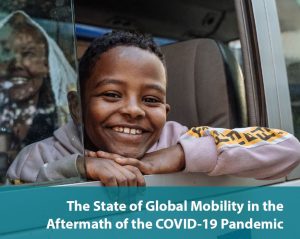Human migration in the wake of COVID-19
Human mobility has returned to pre-pandemic levels, but climate and environmental events have begun to trigger larger, longer-distance movements, a new study says.
 The study, titled ‘The State of Global Mobility in the Aftermath of the COVID-19 Pandemic’, produced by the International Organization for Migration (IOM) and the Migration Policy Institute (MPI), says human mobility has fully rebounded from the sharp downturns seen during the COVID-19 pandemic.
The study, titled ‘The State of Global Mobility in the Aftermath of the COVID-19 Pandemic’, produced by the International Organization for Migration (IOM) and the Migration Policy Institute (MPI), says human mobility has fully rebounded from the sharp downturns seen during the COVID-19 pandemic.
It says this demonstrating the resilience and inevitability of human migration but also that migration is undergoing significant shifts across world regions.
The researchers say movements have fully recovered from pandemic-era restrictions, as well as how they are being shaped by climate and displacement shocks.
They say COVID-19 led to more limited options for regular movement, diverting migrants to more dangerous, irregular routes. Irregular migration also began to stretch over longer distances, exemplified by migrants from origins as far as China transiting the dangerous Darién jungle that spans the Colombia–Panama border.
The report also says that climate and environmental events have begun to trigger larger, longer-distance movements. Cataclysmic floods in Pakistan, which displaced eight million people internally and catalyzed an economic crisis, led to rising numbers leaving their country to find better opportunities elsewhere.
“Mobility has reached a new scale and complexity amid rapid transformations, ranging from the climate crisis to urbanization and digitalization to demographic change,” the researchers said.
“Conflicts and crises in countries from Afghanistan and Ukraine to the Syrian Arab Republic and Sudan have forced millions to move, just as a warming world has turned climate displacement from a future warning into a current reality. Meanwhile, growing demographic asymmetries (as some countries age rapidly while others see their youth population balloon) will continue to deepen the drivers of migration in the decades to come.”
“This uneven landscape indicates that the world is entering an age of disruption for human mobility, the impacts of which are hard to predict,” the researchers said.
Among the region-specific findings in the report are:
- The resurgence of migration to the Gulf Cooperation Countries has established the region’s pre-eminence as the new migration destination. While the pandemic triggered a mass exodus of migrant workers from the Gulf, these countries have seen a rapid recovery of labour migration from South and Southeast Asia, as well as increasing immigration from East Africa.
- Southern Africa is fast becoming a microcosm for a fast-evolving, mobile world. Labor demand in many Southern African countries is being met with an increase in intra-regional, short-term and circular movement. This emulates global trends seeing less reliance on intra-regional permanent labour migration.
- The Taliban takeover in Afghanistan resulted in surprising, not always linear, mobility patterns. Even amid an exodus of refugees fleeing violence and the new regime, the Taliban victory ended decades of conflict, leading to a drop in movements both into and out of the country, as well as a decline in internal displacement.
- Irregular migration to Europe reached the highest levels seen since 2015-16, shifting to dangerous and previously less-used corridors. Even as Europe has tightened enforcement of its borders, migrants have moved to more dangerous routes across the Central Mediterranean and Western Balkans or to less common routes such as the West African/Atlantic route.
- Migration in the Americas has become truly hemispheric. After years of increasing displacement and migration, Latin America is now a region of immigration as well as emigration. People leaving Venezuela — and to some extent, Haiti — have been met with a pragmatic, albeit uneven, welcome in neighbouring countries. But as their displacement becomes protracted, more and more migrants are crossing longer distances that stretch across the hemisphere, with many travelling northward to reach the United States.
Read more: Research: The State of Global Mobility in the Afte.. | migrationpolicy.org












